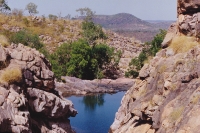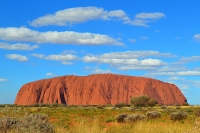Province guides

Attractions
The Northern Territory is best known for its dramatic outdoor attractions: the globally recognisable Uluru (formerly known as Ayers Rock); the Olgas, a remarkable collection of massive domed rocks; Watarrka National Park and the magnificent King's Canyon therein; Kakadu National Park, with its incredible rock art; the Tiwi Islands, home to the Tiwi Aboriginal people; the beautiful, rugged landscapes of Katherine Gorge; and Litchfield National Park, loved for its natural rock pools and waterfalls.
The Northern Territory is also home to some charming towns and cities, and popular travel bases include Darwin, a much-loved tropical, seaside city; Alice Springs, the gateway to the delights of the Australian Outback; Yulara, an isolated resort town situated close to Uluru; Jabiru, a town located within Kakadu National Park; and Katherine, named for the nearby gorge. It is a large but sparsely populated territory and a thorough exploration of the main tourist attractions requires covering quite big distances. Bushwalking, ballooning and fishing are all very popular activities in the region.

Kakadu National Park
Kakadu National Park spans 7,646 square miles (19,804 sq km) of ancient Australian landscape, offering travellers breathtaking scenery at every turn. Visitors can explore sweeping …
Kakadu National Park
Kakadu National Park spans 7,646 square miles (19,804 sq km) of ancient Australian landscape, offering travellers breathtaking scenery at every turn. Visitors can explore sweeping wetlands, dramatic escarpments, hidden gorges, and lush rainforest pockets, all teeming with wildlife. The park is home to more than 5,000 Aboriginal rock art sites, preserving one of the world's oldest living cultures. Easily accessible from Darwin, Kakadu provides unforgettable adventures, including birdwatching, boat cruises, hiking, and waterfall walks. With over 1,600 plant species and a rich variety of animals, it promises an authentic and unforgettable Australian experience.
Website www.parksaustralia.gov.au/kakadu/index.html

Uluru-Kata Tjuta National Park
Uluru, formerly Ayers Rock, rises 1,142 ft (348 m) above the desert and is one of Australia's most iconic landmarks. Located in Uluru‑Kata Tjuta National Park, about 28…
Uluru-Kata Tjuta National Park
Uluru, formerly Ayers Rock, rises 1,142 ft (348 m) above the desert and is one of Australia's most iconic landmarks. Located in Uluru‑Kata Tjuta National Park, about 280 miles (450 km) south‑west of Alice Springs, it's a place of deep spiritual significance for the Anangu people. The best way to experience Uluru is on a guided walk, listening to stories from local guides, or watching the rock's colours change at sunrise and sunset.
Climbing is no longer allowed, but visitors can enjoy base walks, scenic flights, or camel rides. Just 19 miles (30 km) away, Kata Tjuta (the Olgas) rises even higher, offering stunning hiking trails. Nearby Yulara provides resorts, a cultural centre, galleries, and restaurants, making this remote corner of the outback welcoming and easy to explore.
Website www.environment.gov.au/parks/uluru


